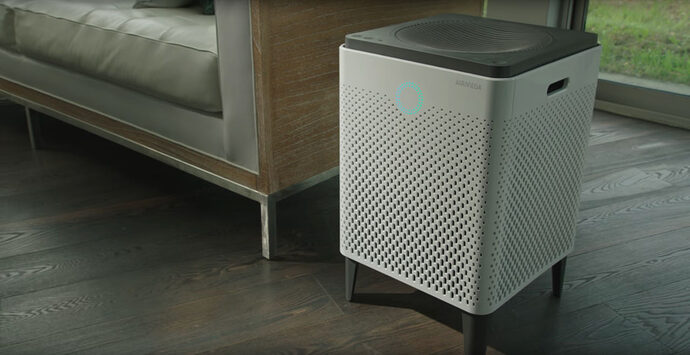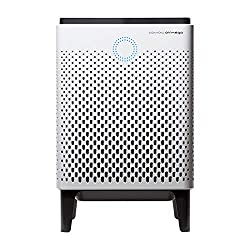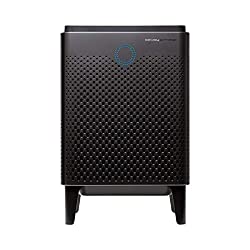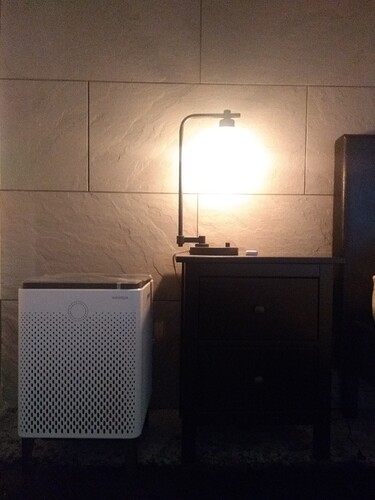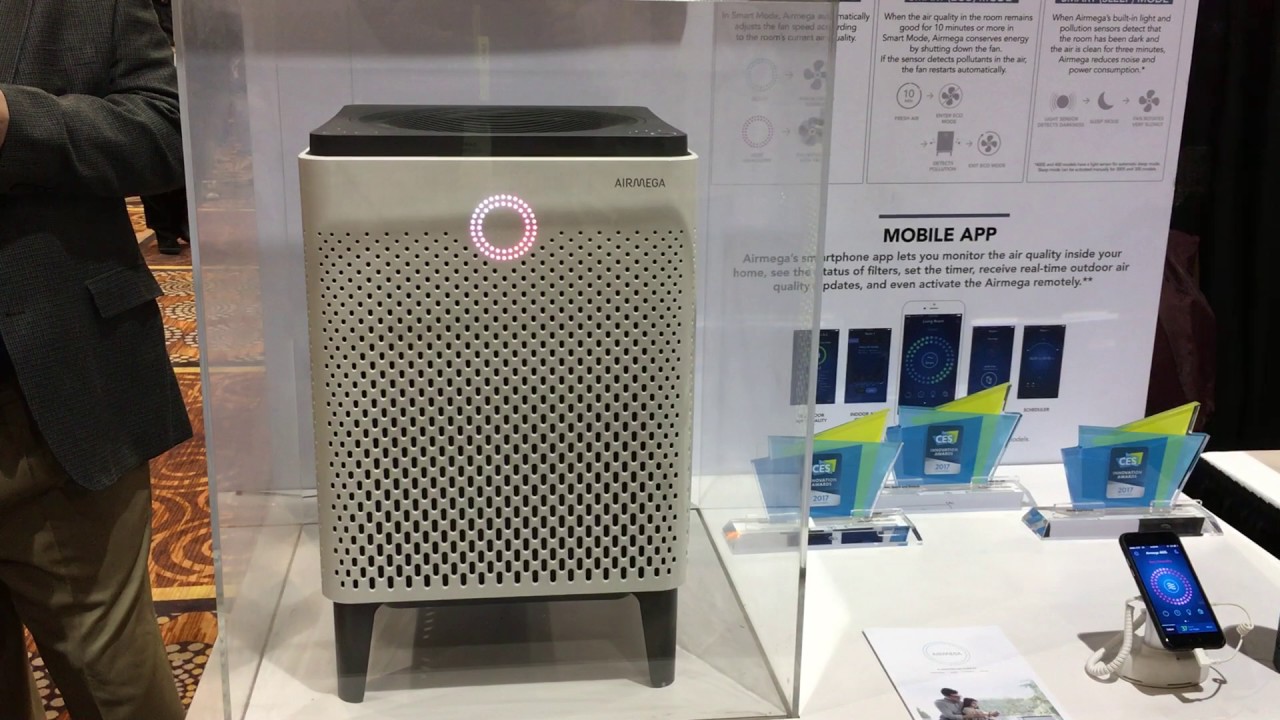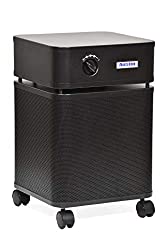This is a comparison post for the Airmega 300 and 400 air purifiers. I’ve written a few additional notes here, but make sure you check out the full review.
Since discovering I have some seasonal allergies about two years ago, I’ve been looking for a decent air purifier. My place is a large studio, about 850 sq ft, and it’s mostly one room. I was looking for a few things:
- Capable of purifying coverage for about 700 sq ft
- Attractive—something I wouldn’t feel like I had to hide
- A smart or eco mode that prevented it from constantly running
- Quiet fans
Eventually, I stumbled upon Coway’s Airmega product line. They were highly rated and covered all of the above. More than anything the Airmega is a sleek-looking device—much more than I expected from an air purifier. The only downside is the price of the units.
Coway Airmega 300
Excellent for large rooms and studio apartments
With dual filters and a powerful, but quiet motor, the Airmega 300 is perfect for rooms between 600 and 1200 sq ft. It's strong performance and attractive design make it a standout among a sea of boring air purifiers.Coway Airmega 400
The best air purifier for very large spaces
Larger and more powerful than the Airmega 300, the Airmega 400 is ideal for spaces 1,200 sq ft or larger. Think very large rooms and open office spaces.So should you get the Airmega 300 or 400?
After some patience I was able to grab an Airmega 400 on sale for about $450. There were a few things that I wasn’t entirely aware of when I made this purchase. I’ve since returned it for a 300, but here are a few things I would be aware of:
Size. The Airmege 400 is huge. Really huge.
Here is a picture of it next to my IKEA Hemnes nightstand. It is about 2 inches shorter, but amlost the same width and depth. The picture here doesn’t really do it justice. It did not fit in the delivery locker at my apartment complex and I had to go pick it up from the post office.
The truth is that I had not done my homework. The 400 is more powerful with 1,560 sq ft of coverage, but it is also much larger—about an inch in every direction. The 300 is still big, but feels much smaller than the 400.
Filter cost difference.
- Max2 filters cost about $120/yr for the 400
- Max2 filters cost about $80/yr for the 300
The Coway Airmega 300 and 400 air purifiers were recently on sale.
Light sensor. The pretty light that helps display the air quality in your home is bright, very bright. In addition to the dust and pollution sensors the 400 has a light sensor that automatically turns the light off at night.
You can always keep the light off. That’s what I’ve done with my 300. But having it auto dim is a nice feature if you’re planning on putting it into your bedroom.
UPDATE: I may need to research this more. Perhaps the 400 does not use the light sensor to turn off the air quality indicator light.
Comparing additional specs
| Specifications | Airmega 300 | Airmega 400 |
|---|---|---|
| Dimensions WxHxD | 13.6 x 21.2 x 13.6in | 14.8 x 22.8 x 14.8in |
| Weight | 21.4 lb | 24.7 pounds |
| Purifying Coverage (2 ACH) | 1,256 sq ft | 1,560 sq ft |
| Purifying Coverage (4 ACH) | 628 sq ft | 780 sq ft |
| Annual filter cost | ~$80 | ~$120 |
| Noise Level | 22~52 dB | 22~52 dB |
| Power usage | 57 W | 66 W |
| Sensors | Dust / Pollution | Dust / Pollution / Light |
What about the 300s and 400s models?
There are newer, smart versions called the Airmega 300s and 400s. These versions come with an app that let you remotely see the air quality in your room and control the Airmega. Personally, I don’t see the point. I’ve just set my 300 to smart mode—it comes on when needed. Otherwise I kind of just forget about it.
The newer S models are also generally $100 to $200 more than the base models. It just doesn’t make sense to pay that much more for an air purifier app.
Would a smaller air purifier work?
Both the Airmega 300 and 400 are both attractive and excellent for large spaces. However, if you have several rooms that you’re looking to purify, it would be more effective to purchase a few air purifiers with less coverage.
Coway manufactures the Airmega 200M and Mighty which might work better in this case. They have about 360 sq. ft. of coverage and cost a fraction as much. If you’re trying to purify your living room, bed room and home office it would be more effective to purchase 3 smaller ones than a single large air purifier. It would cost about the same.
If that sounds more like what you need, take a look at our Coway Airmega 200M vs Mighty AP-1512HH Comparison. One of those should work.
First month of the Airmega 300
It is probably too early give long-term notes. Smart mode seems to work well. Usually the fans are off or on low, which isn’t audible. The only times the purifier kicks into medium and high speeds is when I’m cooking something on the stove top. After about 20 minutes it winds down.
The air quality light is very bright at night. I’ve turned mine off.
That’s about all I have to report thus far.
Coway Airmega 300
Excellent for large rooms and studio apartments
With dual filters and a powerful, but quiet motor, the Airmega 300 is perfect for rooms between 600 and 1200 sq ft. It's strong performance and attractive design make it a standout among a sea of boring air purifiers.Coway Airmega 400
The best air purifier for very large spaces
Larger and more powerful than the Airmega 300, the Airmega 400 is ideal for spaces 1,200 sq ft or larger. Think very large rooms and open office spaces.Long-term notes
Purchased an Airmega 400 in September 2018 and later exchanged it for the smaller Airmega 300. Since a products flaws can appear after months or years of use, I publish my long-term notes here. That way you can determine how buy-it-for-life the product is.
-
February 5, 2021 A few years in the Airmega 300 is still a powerful and reliable air purifier. We’ve spent significantly more time at home because of COVID. Having a good air purifier has made a significant difference.
-
July 2, 2020 I’ve ordered a replacement Max 2 filter. The indicator light finally came on. I had been a little worried that it was broken. The HEPA filters are supposed to be replaced annually. It appears these lasted almost twice that. I suppose the replacement indicator is based on usage and not on a timer. I’d say this is a big win for consumers and just another reason to trust Coway.
-
August 12, 2019 This Airmega 300 review is published. I am still very pleased with the air purifier. It has just enough “smarts” to be effective.
-
March 29, 2019 My replacement air purifier arrived. Fast shipping, no issues.
-
March 26, 2019 The Airmega 300 has a power issue that I believe was caused my an electrical surge in my place. I had to fill out Coway’s warranty registration form and they sent me a shipping label. I did have to pay $15 for a box to put the old device in.
-
November 4, 2018 I published an article comparing the Airmega 300 and Airmega 400.
-
September 4, 2018 I ordered the Airmega 400 and realized that it was much larger than expected. I exchanged it for the slighyly smaller Airmega 300.
Image from Coway
